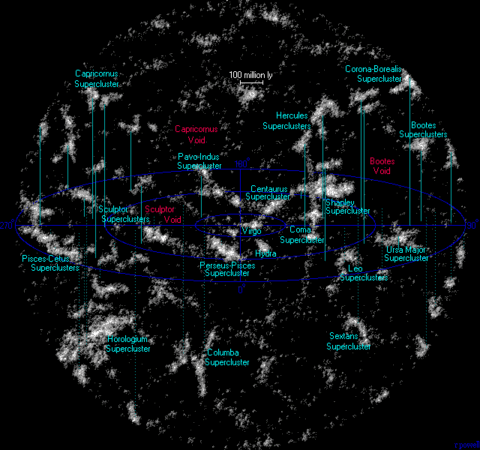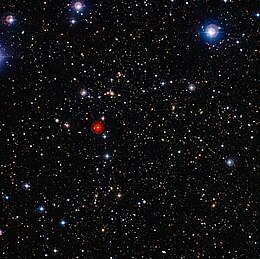Supercluster

A supercluster is a large group of smaller
Existence
The existence of superclusters indicates that the galaxies in the Universe are not uniformly distributed; most of them are drawn together in groups and clusters, with groups containing up to some dozens of galaxies and clusters up to several thousand galaxies. Those groups and clusters and additional isolated galaxies in turn form even larger structures called superclusters.

Their existence was first postulated by George Abell in his 1958 Abell catalogue of galaxy clusters. He called them "second-order clusters", or clusters of clusters.[5]
Superclusters form massive structures of galaxies, called "filaments", "supercluster complexes", "walls" or "sheets", that may span between several hundred million light-years to 10 billion light-years, covering more than 5% of the observable universe. These are the largest structures known to date. Observations of superclusters can give information about the initial condition of the universe, when these superclusters were created. The directions of the rotational axes of galaxies within superclusters are studied by those who believe that they may give insight and information into the early formation process of galaxies in the history of the Universe.[6]
Interspersed among superclusters are large voids of space where few galaxies exist. Superclusters are frequently subdivided into groups of clusters called galaxy groups and clusters.
Although superclusters are supposed to be the largest structures in the universe according to the Cosmological principle, larger structures have been observed in surveys, including the Sloan Great Wall.[7]
List of superclusters
| Galaxy supercluster | Data | Notes |
|---|---|---|
| Einasto Supercluster |
|
Discovered in 2023 by analyzing Sloan Digital Sky Survey images. Claimed to be the most massive galaxy supercluster discovered so far.[8][9] |
| King Ghidorah Supercluster |
|
The most massive galaxy supercluster discovered until 2023.[10] |
| Laniakea Supercluster |
|
The Laniakea Supercluster is the supercluster that contains the Virgo Cluster, Local Group, and by extension on the latter, our galaxy; the Milky Way.[2] |
| Virgo Supercluster |
|
It contains the Local Group with our galaxy, the Milky Way. It also contains the Virgo Cluster near its center, and is sometimes called the Local Supercluster. It is thought to contain over 47,000 galaxies.
A 2014 study indicates that the Virgo Supercluster is only a lobe of an even greater supercluster, Laniakea.[11] |
| Hydra–Centaurus Supercluster | It is composed of two lobes, sometimes also referred to as superclusters, or sometimes the entire supercluster is referred to by these other two names
In 2014, the newly announced Laniakea Supercluster subsumed the Hydra-Centaurus Supercluster, which became a component of the new supercluster.[11] | |
| Pavo–Indus Supercluster |
In 2014, the newly announced Laniakea Supercluster subsumed the Pavo-Indus Supercluster, which became a component of the new supercluster.[11] | |
| Southern Supercluster |
Includes Fornax Cluster (S373), Dorado and Eridanus clouds.[12] | |
| Saraswati Supercluster | Distance = 4000 Million light years (1.2 Gpc )
Length = 652 Million light-years |
The Saraswati Supercluster consists of 43 massive galaxy clusters such as Abell 2361 and has a mass of about 2 x 1016 M☉ and is seen in the Pisces constellation |
Nearby superclusters
| Galaxy supercluster | Data | Notes |
|---|---|---|
| Perseus–Pisces Supercluster | ||
| Coma Supercluster | Forms most of the CfA Homunculus, the center of the CfA2 Great Wall galaxy filament | |
Sculptor Superclusters
|
SCl 9 | |
| Hercules Superclusters | SCl 160 | |
| Leo Supercluster | SCl 93 | |
| Ophiuchus Supercluster |
|
Forming the far wall of the Hercules Supercluster. This supercluster is centered on the cD cluster Ophiuchus Cluster, and has at least two more galaxy clusters, four more galaxy groups, several field galaxies, as members.[13]
|
| Shapley Supercluster |
|
The second supercluster found, after the Local Supercluster. |
Distant superclusters
| Galaxy supercluster | Data | Notes |
|---|---|---|
Pisces–Cetus Supercluster
|
||
| Boötes Supercluster | SCl 138 | |
Horologium–Reticulum Supercluster
|
|
|
| Corona Borealis Supercluster | ||
| Columba Supercluster | ||
| Aquarius Supercluster | ||
| Aquarius B Supercluster | ||
| Aquarius–Capricornus Supercluster | ||
| Aquarius–Cetus Supercluster | ||
| Bootes A Supercluster | ||
| Caelum Supercluster |
|
|
| Draco Supercluster | ||
| Draco–Ursa Major Supercluster | ||
| Fornax–Eridanus Supercluster | ||
| Grus Supercluster | ||
| Leo A Supercluster | ||
| Leo–Sextans Supercluster | ||
| Leo–Virgo Supercluster | SCl 107 | |
| Microscopium Supercluster | SCl 174 | |
| Pegasus–Pisces Supercluster | SCl 3 | |
| Perseus–Pisces Supercluster | SCl 40 | |
| Pisces–Aries Supercluster | ||
| Ursa Majoris Supercluster | ||
| Virgo-Coma Supercluster | SCl 111 |
Extremely distant superclusters
| Galaxy supercluster | Data | Notes |
|---|---|---|
| Hyperion proto-supercluster | z=2.45 | This supercluster at the time of its discovery in 2018 was the earliest and largest proto-supercluster found to date.[15][16] |
| Lynx Supercluster | z=1.27 | Discovered in 1999[17] (as ClG J0848+4453, a name now used to describe the western cluster, with ClG J0849+4452 being the eastern one),[18] it contains at least two clusters RXJ 0848.9+4452 (z=1.26) and RXJ 0848.6+4453 (z=1.27) . At the time of discovery, it became the most distant known supercluster.[19] Additionally, seven smaller groups of galaxies are associated with the supercluster.[20] |
| SCL @ 1338+27 at z=1.1 |
z=1.1 Length=70Mpc |
A rich supercluster with several galaxy clusters was discovered around an unusual concentration of 23 QSOs at z=1.1 in 2001. The size of the complex of clusters may indicate a wall of galaxies exists there, instead of a single supercluster. The size discovered approaches the size of the CfA2 Great Wall filament. At the time of the discovery, it was the largest and most distant supercluster beyond z=0.5 [21][22] |
| SCL @ 1604+43 at z=0.9 | z=0.91 | This supercluster at the time of its discovery was the largest supercluster found so deep into space, in 2000. It consisted of two known rich clusters and one newly discovered cluster as a result of the study that discovered it. The then known clusters were Cl 1604+4304 (z=0.897) and Cl 1604+4321 (z=0.924), which then known to have 21 and 42 known galaxies respectively. The then newly discovered cluster was located at 16h 04m 25.7s, +43° 14′ 44.7″[23] |
| SCL @ 0018+16 at z=0.54 in SA26 | z=0.54 | This supercluster lies around radio galaxy 54W084C (z=0.544) and is composed of at least three large clusters, CL 0016+16 (z=0.5455), RX J0018.3+1618 (z=0.5506), RX J0018.8+1602 .[24] |
| MS 0302+17 |
z=0.42 Length=6Mpc |
This supercluster has at least three member clusters, the eastern cluster CL 0303+1706, southern cluster MS 0302+1659 and northern cluster MS 0302+1717.[25] |
Diagram
See also
References
- ^ Cain, Fraser (4 May 2009). "Local Group". Universe Today. Retrieved 6 December 2015.
- ^ S2CID 124323774.
- ^ "The Universe within 14 billion Light Years". Atlas of the Universe. Retrieved 6 December 2015.
- ^ "An Intergalactic Heavyweight". ESO Picture of the Week. Retrieved 12 February 2013.
- doi:10.1086/190036.
- ^
Hu, F. X.; et al. (2006). "Orientation of Galaxies in the Local Supercluster: A Review". S2CID 18837475.
- S2CID 119215944.
- ^ "Einasto Supercluster: the new heavyweight contender in the universe | Tartu Ülikool". ut.ee. 2024-02-19. Retrieved 2024-03-22.
- ISSN 0004-637X.
- S2CID 253761264.
- ^ S2CID 205240232.
- ISBN 978-1-4613-9358-0. Archived from the originalon 9 June 2018. Retrieved 23 September 2020.
- ^ Hasegawa, T.; et al. (2000). "Large-scale structure of galaxies in the Ophiuchus region". .
- doi:10.1086/114635.
- ^ Miranda, Natalia A. Ramos (October 17, 2018), Scientists in Chile unveil 'A Cosmic Titan' cluster of galaxies, Reuters
- S2CID 119472428.
- ^
Rosati, P.; et al. (1999). "An X-Ray-Selected Galaxy Cluster at z = 1.26". S2CID 2560006.
- ^ "Lynx Supercluster". SIMBAD.
- ^
Nakata, F.; et al. (2004). "Discovery of a large-scale clumpy structure of the Lynx supercluster at z∼1.27". ISBN 0-521-84908-X.
- ^
Ohta, K.; et al. (2003). "Optical Identification of the ASCA Lynx Deep Survey: An Association of Quasi-Stellar Objects and a Supercluster at z = 1.3?". S2CID 117171639.
- ^
Tanaka, I. (2004). "Subaru Observation of a Supercluster of Galaxies and QSOS at Z = 1.1". Studies of Galaxies in the Young Universe with New Generation Telescope, Proceedings of Japan-German Seminar, held in Sendai, Japan, July 24–28, 2001. pp. 61–64. Bibcode:2004sgyu.conf...61T.
- ^
Tanaka, I.; Yamada, T.; Turner, E. L.; Suto, Y. (2001). "Superclustering of Faint Galaxies in the Field of a QSO Concentration at z ~ 1.1". S2CID 119439816.
- S2CID 14588174.
- ^
Connolly, A. J.; et al. (1996). "Superclustering at Redshift z = 0.54". S2CID 17697662.
- ^ University of Hawaii, "The MS0302+17 Supercluster", Nick Kaiser. Retrieved 15 September 2009.
- Freedman, Roger; Gellar, Robert M.; Kaufmann, William III (2015). "Galaxies". Universe (10th ed.). New York: W.H. Freedman. ISBN 978-1-319-04238-7.
